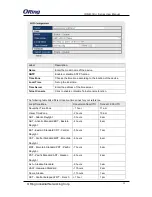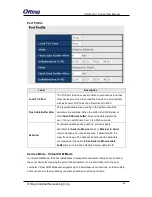
IDS-4312(+) Series User Manual
ORing Industrial Networking Corp
39
control bit modes include None, Odd, Even, Mark, and Space.
None
: parity checking is not performed and the parity bit is not
transmitted.
Odd
: the number of mark bits in the data is counted, and the
parity bit is asserted or unasserted to obtain an odd number of
mark bits.
Even
: the number of mark bits in the data is counted, and the
parity bit is asserted or unasserted to obtain an even number of
mark bits.
Mark
: the parity bit is always set to the mark signal condition
(logical 1)
Space
: the last transmitted data bit will always be a logical 0.
Flow Control
Serial communication consists of hardware flow control and
software flow control, so called as the control is handled by
software or hardware.
XOFF
and
OXN
is software flow control
while
RTS/CTS or DTR/DSR
is hardware flow control.
Choose
XOFF
to tell the computer to stop sending data; then the
receiving side will send an XOFF character over its Tx line to tell
the transmitting side to stop transmitting. Choose
XON
to tell the
computer to begin sending data again; then the receiving side
will send an XON character over its Tx line to tell the transmitting
side to resume transmitting. In hardware flow control mode,
when the device is ready to receive data, it sends a CTS (Clear
To Send) signal to the device on the other end. When a device
has something it wants to send, it will send a RTS (Ready To
Send) signal and waits for a CTS signal to come back its way.
These signals are sent apart from the data itself on separate
wires.
FaceTX Interval Time
Force TX interval time is to specify the timeout when no data has
been transmitted. When the timeout is reached or TX buffer is full
(4K Bytes), the queued data will be sent.
0
means disable.
Factory default value is
0
.
Performance
Throughput
: This mode optimized for highest transmission
speed.
Latency
: This mode optimized for shortest response time.














































